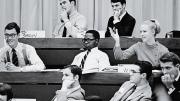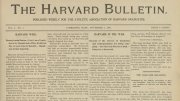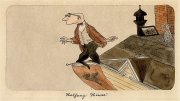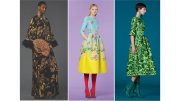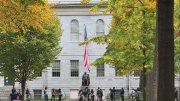Harvard Business School (HBS) commemorated the entry of women into its M.B.A. program, half a century ago, with the W50 Summit in early April—complete with a survey of alumnae and the announcement of a new senior associate deanship for culture and community (see www.harvardmag.com/hbs-13 for a full report). A related exhibit, Building the Foundation: Business Education for Women at Harvard University, at Baker Library|Bloomberg Center through September 22, documents that progress from Radcliffe College’s one-year certificate program in 1937 to the residential integration of women at HBS in 1970.
A two-page, typewritten memorandum in the exhibit, to “The Women of the Class of 1971” on the subject of “Life at H.B.S.,” composed by Robin Wigger, Class of 1970, gives a vivid sense of the world then, for women and men alike.
Written “in an attempt to answer some of the questions which I had last summer before beginning the MBA Program,” it starts with the “vital” suggestion that “every woman have a fairly definite reply to the question: ‘What’s a nice girl like you doing in business school?’” Wigger explained the context:
I do not wish to imply that you will be regarded as some sort of freak, for many times…this question is intended as a compliment. But I would like to warn you that the question will be a constant one, and it does help if you have a ready answer. Some of the first-year men appeared to assume that most of the single girls at HBS were there with the sole intent of finding rich husbands. Others really could not understand why any woman would want to learn about business and/or management.
From there, Wigger offered practical advice on “exactly what women were expected to wear to class.” Most of her peers, she noted, chose “clothes appropriate to the suits and ties of the male students. We wore dresses or suits with low heels and hose.” One consequence: “[I]f you just graduated from an all-women’s college, you may find the switch in dress to be a bit of a shock to your clothes budget (especially the cost of nylons).”
After advising matriculating women to relax and be confident that they could adjust to the workload, to “classes in which there is a strong emphasis on discussion,” and to “the frightening possibility of being called on to start a class,” Wigger revealed her pioneering spirit. She and three other first-year women had participated in an “Experimental Residence Project” during the second half of the year, “to determine the adequacy of the facilities for women and also to discover whether there were any major problems for women living in the men’s dorms.” All four, she wrote, “deemed the experiment a great success and have chosen to live on campus again,” in part to belong to study groups, use the library, and meet people. None suffered the imagined problem of “a possible loss of our (feminine) identity.” The accommodations were far better than those of Radcliffe Graduate Center—although women who chose campus living must “provide your own iron and ironing board.”
(A Harvard Crimson report of March 11, 1969, on “the only coed living plan at present in the University,” quoted Colleen Burke, who petitioned with Wigger to live on campus, to the effect that the HBS administration had been “flexible and progressive despite its conservative image.” They and “two other girls” drawn by lot, Peggy Jones and Dana Holzinger, inhabited McCulloch C-13 and -14, previously a lounge for female students. Wigger reported that “now guys can understand more why we’re here. A lot of guys have found out that girls are absolutely normal.” Men had apparently overcome initial misgivings, including, Burke said, complaints about “perfume wafting up the corridors.”)
Wigger concluded, “I would not be providing you with an accurate picture if I stated that being a woman at HBS involves no additional problems or adjustments than those faced by the male students. However, the difficulties are not insurmountable and the personal experience and education” well worth it. Apparently so: she went on to be general manager, distribution and marketing, of IBM and, subsequently, a corporate director.
